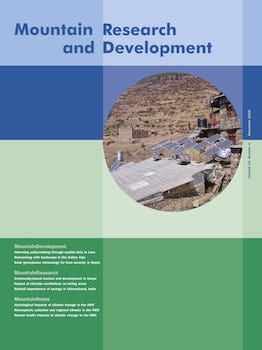Aconcagua: The Invention of Mountaineering on America's Highest Peak by Joy Logan. Tucson, AZ: University of Arizona Press, 2011. x + 251 pp. US$35.00. ISBN 978-0-8165-2950-6.
As the tallest mountain in America, located in a relatively poor region of western Argentina, close to the city of Mendoza, Aconcagua is portrayed in this book as meeting point, melting pot, and agent of change. Standing some 6962 m above sea level, this is the highest mountain in the world outside Asia. Aconcagua acts as a place where culture, class, gender, nationhood, race, wealth, and the worldviews of a range of mountaineers, tourists, and adventurers intersect. Logan's book sketches out some of these dialectical relations via ethnographic research, cultural observation, and literary review, providing a commentary that touches upon the progress of modernity, feminist theory, and capitalism in this context.
During this endeavor, the reader is treated to some insightful objective perspectives on the roles of the people who pay to play on the mountain and of those who would earn their livelihood by facilitating these experiences. As the mountain resort struggles with its growing significance in the world as a destination for adventure, so the contestation between the status of the local mixed-race Arrieros in this glamorous realm and their adventuring “hero” clients and imported guides is undergoing a parallel struggle. The management of perceived risk via processes of service provider selection, so fundamental to Western consumer practice, can easily render the years of experience and successful guiding by locals less valuable. The locals cannot always demonstrate their abilities via the rationalized, authoritative stamp of international guiding qualifications and therefore cannot prove their abilities objectively. Yet this is just one of many examples that Logan offers of how this towering peak generates conflict and inequality, stimulating questions about global engagement with wild places, indigenous cultures, emergent economies, and turbulent histories. Tourism itself, as a global and globalizing phenomenon, is examined through the international and Mendocino mountaineering lens. It is found to be promising, in terms of its potential to deliver foreign income and strong currency through invisible exports of experiences and encounters. It is also found wanting, however, as the forces of capitalist enterprise overcome local conservation initiatives, and the keenness of local people to boost tourist spending means that they encourage ever-greater numbers to flock to the region, straining resources.
One might perhaps expect the book to provide thick description; wonderfully textured portrayals of the mountaineering communities who live and recreate on and around Aconcagua, or else moments of deep investigation into the nature of mountaineering in the 21st century seen through a particular disciplinary lens. Such perspectives are, to some extent, provided from chapter 6 onward, with the foregrounding writing serving as a work of reference on the interplay between this mountain, its people, and the rest of the world. The fact that the narrative seems heavily weighted toward the Mendocino perspective may be one reason that the general story seems thin and frustratingly often lacks balance.
Perhaps Logan strives to do too much and sacrifices depth for what is an impressive breadth of coverage. Somehow, after thumbing the pages of the book, one is still left wondering what being on Aconcagua is like, how it would feel to be among the temporary, ever-shifting community of mountaineers from all backgrounds and corners of the world, and how it works. There is insufficient concern for the cocreated, negotiated meanings generated in the multitudinous encounters in and around the mountain: the existentially authentic moments of connection and discord between strangers, whose fleeting relationship is mediated by the place. Nevertheless, the chapter “Plaza de Mulas” provides a good sketch of the scene. For example, the emergence of blogs and websites is discussed, exploring the ways these have mediated the meanings associated with the place. Indeed, for those seeking more of this type of insight, I would direct readers to the ethnographically informed chapters 6, 7, and 8 in particular, where there are some fascinating stories of the developed world meeting the locals who ply their trades on the mountain as cooks, porters, and guides. The confused meaning of the North Face brand, for example, is explained: North faces of mountains in the Northern hemisphere are the coldest and often the hardest; in the Southern hemisphere, however, south-facing faces are most challenging, and as such this global brand finds a curiously misplaced position among the mountaineering Mendocinos of the region.
Overall, this is a useful book to dip into, to search for key words or applied concepts and theories in the index, or to learn about the development of mountaineering in South America from a rather particular, indigenous perspective. The missing element seems to be the experience of the mountain and its peoples: the reader is left wanting in terms of the subjectivities of the place and its story but is instead rewarded with insightful gems about the confluence of global society, mountain tourism, and economic development, which punctuate the entire book. As a commentary on the commodification of adventure and its winners, losers, and discontents, this book provides an interesting and powerful case study.





